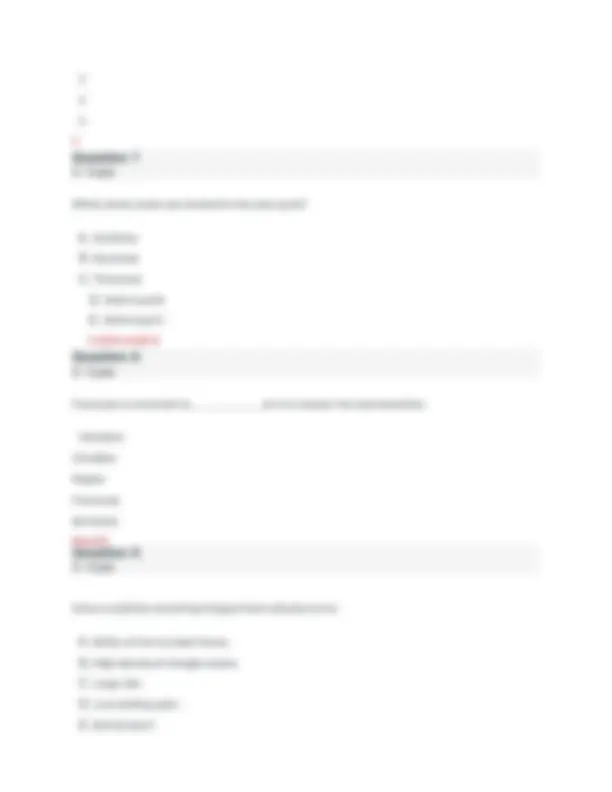









Study with the several resources on Docsity

Earn points by helping other students or get them with a premium plan


Prepare for your exams
Study with the several resources on Docsity

Earn points to download
Earn points by helping other students or get them with a premium plan
Community
Ask the community for help and clear up your study doubts
Discover the best universities in your country according to Docsity users
Free resources
Download our free guides on studying techniques, anxiety management strategies, and thesis advice from Docsity tutors
A series of questions and answers related to biochemistry, specifically focusing on the urea cycle, the electron transport chain (etc), and atp synthesis. It includes true/false questions, multiple-choice questions, and fill-in-the-blank questions, along with some short-answer explanations. The questions cover topics such as the location of reactions within the cell, the roles of different molecules in the cycles, and the structure and function of mitochondria. Designed as a study aid or exam review for students learning about these biochemical processes. It provides verified answers, aiming to guarantee a passing grade. The content is suitable for students studying biochemistry or related fields, offering a way to test their knowledge and understanding of key concepts.
Typology: Exams
1 / 13

This page cannot be seen from the preview
Don't miss anything!








3 / 3 pts
3 / 3 pts
3 / 3 pts
3 / 3 pts
3 / 3 pts
True or False: The majority of reactions of the urea cycle occur in the cytosol. TRUE True or False: NADH yields 1.5 ATP molecules after donating electrons and hydrogenatoms to the electron transfer chain (ETC). FALSE True or False: GTP is invested in the urea cycle. FALSE True or False: There are six complexes associated with the ETC. FALSE True or False: In the production of ATP via ATP synthase, the H+ ions move from the mitochondrial matrix to the intermembrane space. FALSE
3 / 3 pts
The urea cycle involves reactions (only those in the cyclic portion of the process). 1 2
Question 10
3 / 3 pts B. HIGH DENSITY OF NITROGEN ATOMS is both a component of the urea cycle and the citric acid cycle. Malate Acetyl-CoA Citrate Fumarate None of the above FUMARATE Deamination of an amino acid results in a carbon skeleton and in the production of . A. NH 2 B. NH
3 / 3 pts
3 / 3 pts
The following chemical species is. Ammonium Fumarate Arginine Argininosuccinate Urea UREA FADH 2 donates electrons and H+ to complex. I II
3 / 3 pts
3 / 3 pts Inner membrane Outer membrane Both B and C MATRIX At which complex does the following reaction take place? O 2 + 4e- + 4H+ → → 2H 2 O Complex I Complex II Complex III Complex IV Both A and B COMPLEX IV During the electron transport chain, protons are pumped from in the mitochondria. From the intermembrane space to the cytosol From the intermembrane space to the matrix From the matrix to the intermembrane space From outside of the cell to the cytosol From outside of the cell to the matrix
3 / 3 pts
3 / 3 pts
3 / 3 pts FROM THE MATRIX TO THE INTERMEMBRANE SPACE Energy released is utilized for the synthesis of ATP. As protons flow through ATP synthase and back into the mitochondrial matrixIn the digestion of proteins In the degradation of carbohydratesIn the formation of ATP None of the above AS PROTONS FLOW THROUGH ATP SYNTHASE AND BACK INTO THE MITOCHONDRIALMATRIX The H+ ions flow through what part of the ATP synthase? A. FO B. F 1 C. F 2 D. Stator E. Both A and C A. FO An individual with the MERRF disease, tend to have symptoms of.
4 / 5 pts Which of the following is not a part of ATP synthase? A. F B. FO C. F 1 D. F 2 E. Both A and D E.BOTH AND D (Fill in the blanks) Use the word bank to fill in the following blanks. In the word bank, each word or words is separated by semicolons. Words can be used more than once,and not all words will be used. Word bank : ADP and Pi; ATP; GTP; oxidative; reductive; citric acid cycle; electrontransport chain; three; eight; ten The (A) produces NADH and FADH 2 which can then be used to produce (B). Oxidative phosphorylation is the synthesis of (C) from (D) , using energy generated by the oxidative reactions during the (E).
3 / 3 pts
7 / 10 pts
10 / 10 pts A) citric acid cycle B) ATP C) ATP D) ADP and Pi E) electron transport chain According to the chemiosmotic theory, how is the ETC connected to ATP production?Explain in at least four complete sentences. The chemical reactions of the ETC provide energy to pump H+ ions from the mitochondrial matrix into the intermembrane space. The reactions also provide electrons and H+ to convert oxygen into water. The net resultis that the H+ gradients permit a flow H+ to rotation ATP synthase, producing ATP. nt is formed more clearly (be specific that the ETC transport creates a gradient). Consider the importance of the mitochondria in energy production. A. What structural features of mitochondria support ATP formation? And